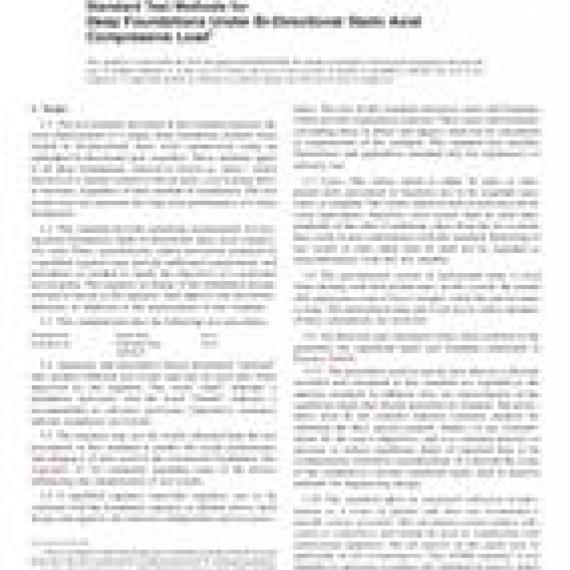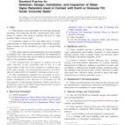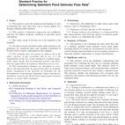-
 1xGMW16071
$139.30
1xGMW16071
$139.30 -
 1xISO 22772:2020
$30.60
1xISO 22772:2020
$30.60 -
 1xRTCA DO-319
$165.94
1xRTCA DO-319
$165.94 -
 1xISO 23044:2020
$46.35
1xISO 23044:2020
$46.35 -
 1xAWS Bundle A:2011
$0.00
1xAWS Bundle A:2011
$0.00 -
 1xGMW17687
$46.20
1xGMW17687
$46.20 -
 1xRTCA DO-294C
$112.50
1xRTCA DO-294C
$112.50
No products
ASTM D8169/D8169M-18
ASTM D8169/D8169M-18 Standard Test Methods for Deep Foundations Under Bi-Directional Static Axial Compressive Load
standard by ASTM International, 01/01/2018
Full Description
1.1The test methods described in this standard measure the axial displacement of a single, deep foundation element when loaded in bi-directional static axial compression using an embedded bi-directional jack assembly. These methods apply to all deep foundations, referred to herein as piles, which function in a manner similar to driven piles, cast in place piles, or barrettes, regardless of their method of installation. The test results may not represent the long-term performance of a deep foundation.
1.2This standard provides minimum requirements for testing deep foundations under bi-directional static axial compressive load. Plans, specifications, and/or provisions prepared by a qualified engineer may provide additional requirements and procedures as needed to satisfy the objectives of a particular test program. The engineer in charge of the foundation design, referred to herein as the engineer, shall approve any deviations, deletions, or additions to the requirements of this standard.
1.3This standard provides the following test procedures:
| Procedure A | Quick Test | 9.2.1 |
| Procedure B | Extended Test (optional) | 9.2.2 |
1.4Apparatus and procedures herein designated optional may produce different test results and may be used only when approved by the engineer. The word shall indicates a mandatory provision, and the word should indicates a recommended or advisory provision. Imperative sentences indicate mandatory provisions.
1.5The engineer may use the results obtained from the test procedures in this standard to predict the actual performance and adequacy of piles used in the constructed foundation. See Appendix X1 for comments regarding some of the factors influencing the interpretation of test results.
1.6A qualified engineer (specialty engineer, not to be confused with the foundation engineer as defined above) shall design and approve the load test configuration and test procedures. The text of this standard references notes and footnotes which provide explanatory material. These notes and footnotes (excluding those in tables and figures) shall not be considered as requirements of the standard. This standard also includes illustrations and appendixes intended only for explanatory or advisory use.
1.7Units-The values stated in either SI units or inch-pound units (presented in brackets) are to be regarded separately as standard. The values stated in each system may not be exact equivalents; therefore, each system shall be used independently of the other. Combining values from the two systems may result in non-conformance with the standard. Reporting of test results in units other than SI shall not be regarded as nonconformance with this test method.
1.8The gravitational system of inch-pound units is used when dealing with inch-pound units. In this system, the pound (lbf) represents a unit of force (weight), while the unit for mass is slugs. The rationalized slug unit is not given, unless dynamic (F=ma) calculations are involved.
1.9All observed and calculated values shall conform to the guidelines for significant digits and rounding established in Practice D6026.
1.9.1The procedures used to specify how data are collected, recorded and calculated in this standard are regarded as the industry standard. In addition, they are representative of the significant digits that should generally be retained. The procedures used do not consider material variation, purpose for obtaining the data, special purpose studies, or any considerations for the users objectives; and it is common practice to increase or reduce significant digits of reported data to be commensurate with these considerations. It is beyond the scope of this standard to consider significant digits used in analysis methods for engineering design.
1.10This standard offers an organized collection of information or a series of options and does not recommend a specific course of action. This document cannot replace education or experience and should be used in conjunction with professional judgment. Not all aspects of this guide may be applicable in all circumstances. This ASTM standard is not intended to represent or replace the standard of care by which the adequacy of a given professional service must be judged, nor should this document be applied without consideration of a project's many unique aspects. The word Standard in the title of this document means only that the document has been approved through the ASTM consensus process.
1.11This standard does not purport to address all of the safety concerns, if any, associated with its use. It is the responsibility of the user of this standard to establish appropriate safety, health, and environmental practices and determine the applicability of regulatory limitations prior to use.
1.12This international standard was developed in accordance with internationally recognized principles on standardization established in the Decision on Principles for the Development of International Standards, Guides and Recommendations issued by the World Trade Organization Technical Barriers to Trade (TBT) Committee.


































